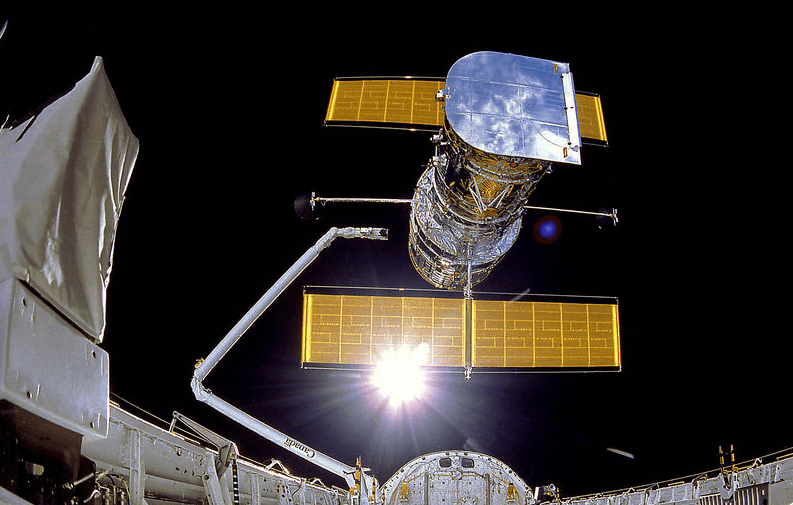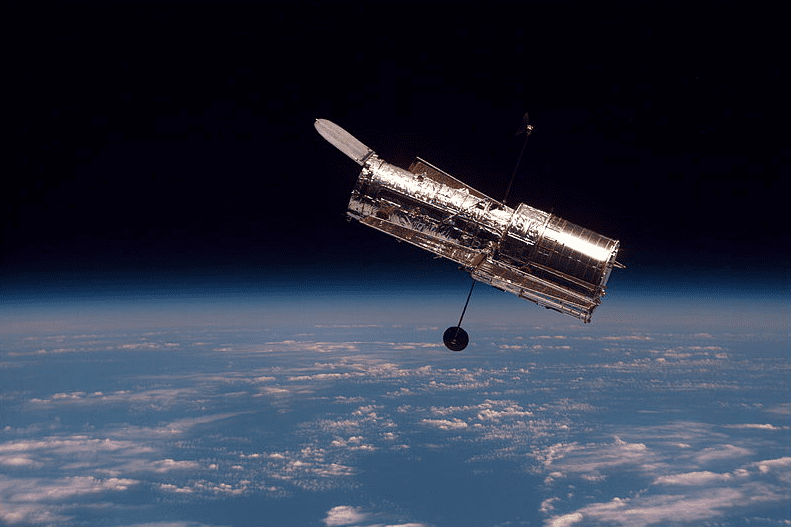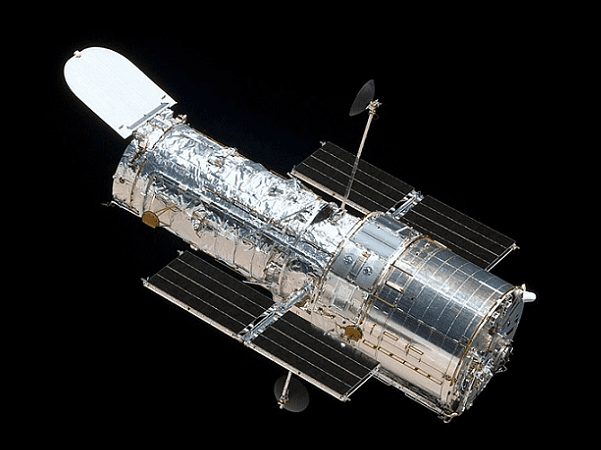After seven long years of frustrating delays – caused first by budget woes and technical difficulties, then by the fatalities of the 1986 space shuttle Challenger disaster – the Hubble Space Telescope was finally launched into space on 24 April 1990, carried aloft by the space shuttle Discovery.

When the Discovery’s mechanical arm lifted the Hubble out of the cargo bay the next day and dropped it into orbit 330 nautical miles above the Earth, astronomers gained a magical eye enabling them to peer deeply into the universe, their vision unobstructed by distortions caused by the Earth’s atmosphere. A new era in astronomy had begun.
Although it ultimately fulfilled astronomers’ hopes and expectations, the Hubble was not without problems – beginning with technical delays scrubbing its projected 1983 launch. Scientists and engineers put the delay time to good use, constantly servicing the giant telescope to keep it operational while at the same time making improvements – at the staggering cost of more than $6 million per month. When the 43-foot-long telescope was finally launched in 1990, it carried a $1.5 billion price tag (its original cost estimate was $400 million). The Hubble’s problems and costs continued after launch, however.
Shortly after it became operational, scientists discovered that Hubble’s gigantic 94.5-inch mirror was flawed: it had not been shaped correctly in the grounding process, resulting in fuzzy images for objects farthest away. Fortunately, the Hubble was designed to be serviced by the same space shuttle program that launched it, and a repair mission in 1993 fully restored the space telescope.

In fact, during its lifetime (the Hubble is still operational today), five shuttle service missions maintained, repaired, and improved the space telescope. Although originally intended to last 15 years, the Hubble has been peering into space and beaming back astonishing images for 28 years. With the space shuttle program now ended there will be no more shuttle service missions, but the Hubble is expected to continue working until 2030 and perhaps longer.
Over the years of its service the Hubble Space Telescope has enchanted the public with breathtaking pictures of outer space and objects from the farthest reaches of the universe. The field of astrophysics has benefited immensely from Hubble’s capabilities, helping scientists verify that the universe is in fact expanding, and aiding calculations of the rate of that expansion and even the age of the universe itself.
The following two newspaper articles are about the successful launch of the Hubble Space Telescope. The first article is a news report of the launch, and the second is an editorial praising the space telescope as an exciting scientific instrument that will expand humankind’s knowledge.
Here is a transcription of this article:
Telescope in Space after Seven-Year Wait
By Harry F. Rosenthal
Associated Press Writer
CAPE CANAVERAL, Fla. (AP) – Seven years late, the Hubble Space Telescope is where it belongs: out of this world and in search of others so distant that they may have been formed at the beginning of time.
Less than five hours after it rode into space aboard the shuttle Discovery on Tuesday, the $1.5 billion telescope sent its first test radio signal. At the sign of life, applause and cheers erupted at the Goddard Space Flight Center in Maryland where astronomers monitored their spacecraft.
“As near as we can tell, everything looks perfect,” said astronomer Steve Hawley from the shuttle. Hawley’s job on Wednesday will be to drop the telescope overboard for a 15-year stay in space.
Discovery, trailing an arc of white smoke into a brilliant blue sky, carried the silver-colored telescope to an orbit 380 miles above Earth – higher by 70 miles than any previous shuttle. There, the Hubble will stay to search for yet-unseen wonders of creation with instruments that can look 14 billion years backward in time.
Each trip around the Earth was taking the Discovery crew 97.3 minutes, longer than on any previous shuttle flight because of the altitude. The view was different, too.
“I’ve got to tell you, I just made it up to the flight deck for a first look out the window,” said mission specialist Kathryn Sullivan, who flew the shuttle once before, in 1984. “Three-thirty is a whole lot higher than 120 was,” she said, referring to the altitude in nautical miles. “I don’t know how much longer it takes you to get here, but every second of the wait is worth every second that you get.”
“Our window on the universe!” NASA launch commentator George Diller exulted as the Discovery rose off its seaside launch pad.
“It’s a beautiful day to have Hubble Space Telescope in orbit instead of here on Earth like it’s been for so many years,” said NASA administrator Richard Truly. “Hubble’s in its element and I’m delighted.”
The telescope was supposed to be launched in 1983, but technical problems and the Challenger accident delayed its deployment. It suffered a further delay two weeks ago when the countdown was stopped at the four-minutes-to-go point because of a faulty hydraulic unit on the shuttle.
While it remained on Earth, the telescope cost $7 million a month to exercise and keep in readiness. In its first day in space, that checkout and testing continued remotely under control of the Goddard center.
On hand to watch the Discovery launching was a contingent of scientists who have hailed the Hubble as the greatest advance in astronomy since Galileo raised a small telescope to his eyes nearly 400 years ago.
Truly referred to the early-day astronomer when he was asked about the long delays in getting the telescope to its working station.
“Somebody the other day said, ‘Who remembers the day that Galileo picked up his telescope to look at the stars?’” said Truly, a former shuttle astronaut. “It doesn’t matter what day we launch Hubble, it matters that we do it right.”
The telescope is 43 feet long and 14 feet in diameter, about the size of a railroad tank car. When it flies free, it will receive electrical power for its six scientific instruments from two wing-like solar arrays that extent outward on each side.
It is named after the late astronomer Edwin P. Hubble, who theorized that the universe was expanding and that the farther away a galaxy is, the faster it is traveling. That gave support to the theory that a massive explosion – the Big Bang – created the universe 10 to 20 billion years ago.
The Hubble is expected to help provide the answer to two major questions: How old is the universe? How big is it?
The telescope has two mirrors, one 94.5 inches in diameter, the other 12 inches. Two of the instruments are cameras, two are spectrometers and one is a photometer. In addition, the fine pointing system acts as a sixth instrument by providing precise measurement of distances.
On Wednesday, Hawley is to grapple the 12½-ton telescope with the shuttle’s mechanical arm, lift it out of the cargo bay, point it, and – after a long checkout – drop it overboard to orbit on its own.
In the cargo bay, the telescope receives electrical power from the shuttle.
Here is a transcription of this article:
Hubble on the Universe
Cresting into orbit on a near-perfect launch, the Hubble Space Telescope portends a new era in space learning. Unclouded by Earth’s atmosphere, its giant mirrored lenses should be able to see back 14 billion years, to the universe’s hypothesized beginnings. They should record, in stunning detail, the topography of our near neighbors in the solar system. They may even foretell the way in which the universe will end – whether in infinite expansion or implosion, the Big Bang recycled.
True, the scope is seven years late and hundreds of millions of dollars over original estimates. Its present $1.5 billion cost should grow to more than $2.8 billion as maintenance, operation and other costs are added over the next several years. It cost NASA $7 million monthly just to keep the scope ready to go after its first launch was scrubbed [in 1983].
But the opportunities to expand knowledge about what lies out there are limited only by the ability of the scope to function. That ability is substantially enhanced by the shuttle, which will follow and disgorge screw-driver-wielding, space-walking astronauts as needed after the telescope is deployed today. The telescope is also a tribute to the persistence of the nation’s scientific community in shepherding the project past the Challenger disaster.
Exploration is a search for knowledge as well as riches. The Hubble Space Telescope is bound to take the former in unpredictable directions, perhaps to point us to other galaxies where life is possible or exists now. But “now” is relative, as the scope will also show us, a continuum of billions of years of formation, deformation and vast unknowns.
Note: An online collection of newspapers, such as GenealogyBank’s Historical Newspaper Archives, is not only a great way to learn about the lives of your ancestors – the old newspaper articles also help you understand American history and the times your ancestors lived in, and the news they talked about and read in their local papers, as well as more recent events.
Related Articles:
